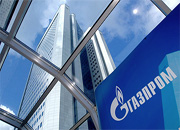It was in the outgoing crisis year when Gazprom started constructing the Nord Stream gas trunkline scheduled for commissioning in the new year of 2011. The legal basis is being shaped for the South Stream project execution, the gas industry is being shaped in Eastern Russia, new giant fields are under development on the Yamal Peninsula and in Eastern Siberia, gasification is ongoing across Russian regions.

Nord Stream gas pipeline construction
In Eastern Russia Gazprom is firmly establishing itself as an anti-crisis manager. After the successful startup of the Sakhalin II project, Gazprom joined the project for gas supply to Kamchatka. In September natural gas from the Kshukskoye field was delivered to CHPP-2 in Petropavlovsk-Kamchatsky. Initiated in the past century, the project was successfully implemented providing energy independence to the region. Welding of the 1,350-kilometer Sakhalin – Khabarovsk – Vladivostok gas pipeline was initiated eighteen months ago. Nowadays, construction operations are at the final stage. Moreover, Russia's first coalbed methane (CBM) production facility was commissioned this year. Thus, Gazprom developed its own technique for unconventional gas extraction and is willing to share it with the partners. A similar CBM project in Ukraine will be the first example of the technology export.

While dealing with large-scale investment projects, the Company also continues efforts on raising the investment appeal of its shares and defending shareholders' interests. In 2010 the debt load diminished significantly and the net income determined under IFRS and based on the mid-2010 results grew by 67 percent – up to RUB 0.5 billion. The Company approved the revised version of the Dividend Policy: the maximum dividend amount was raised from 17.5 to 35 per cent of the parent company's net income under Russian accounting standards (RAS) and the dividend base was cleared of the “paper” items unsecured by the real cash flow.
The industrial and infrastructure projects being implemented as well as successful financial management and corporate governance firmly indicate that Gazprom's capitalization growth will be sustained.


